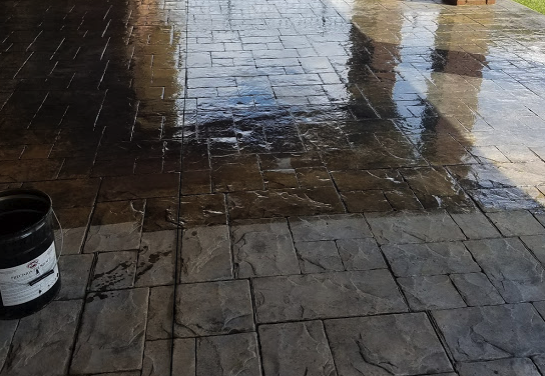
Concrete Sealing in Birmingham
Once you have decided to add a stamped or colored concrete area to your home or business, then it is very important for you to take care of your new space. Stamped concrete is actually a very low-maintenance material to care for, but a few preventative measures will ensure many years of enjoyment.
One process that is vital is sealing the concrete. Sealing your finished project helps to prolong the life of the detailed workmanship that has just been incorporated. First-time sealing on your decorative concrete slab is performed in a multi-step process. It’s important that each step be performed in order to achieve maximum coverage.
Step one is to ensure that the decorative concrete slab is completely dried and cured. If the concrete is still damp when the sealer is applied, then the moisture may become trapped between the concrete surface and the sealer. This could be potentially very problematic if moisture becomes trapped because it may lead to the formation of bubbles or chips across the surface.
Step two involves applying very, very thin layers of sealer at a time, and allowing each layer to completely dry between coats. This process is quite time-consuming and requires much patience from the person applying the sealing coats.
Lastly, it is important that once the sealer has been thoroughly applied, it has an adequate amount of time to dry before any foot traffic (from people, cars, or animals) cross over the surface. It is also important to avoid contact with water during this drying time period; therefore, be mindful of weather predictions and water sprinkler patterns.
Decorative Concrete Resealing
Resealing aged decorative concrete surfaces is also important for its maintenance program. Resealing is often recommended every few years; however, it is important to keep in mind how much wear and tear has occurred on your particular piece of concrete. You may find that some slabs need to be resealed sooner than others.
Resealing a previously sealed piece of concrete is a bit different than applying the original sealer. Originally, the sealing agent must have a strong bond with a plain surface of concrete. Resealing, however, requires that the sealant adheres to the already existing, yet aging, sealer. If there are any imperfections in the original sealer, then replacing new sealer on top of it will not correct the problems. Therefore, any problematic areas need to be addressed prior to performing additional sealer.
Years ago, the major trends of concrete sealer were to use a high-gloss coat. More recently, though, property owners have begun using satin finishes or matte finishes. The type of sealer you choose is your own personal preference. High gloss sealers leave a beautiful, shiny coat on the concrete. If it is on top of stained concrete, then the colors appear very vivid and lively with a high-gloss finish. Satin or matte finishes are not as shiny, but still provide a beautifully protective coating over the concrete. Many people believe that a duller finish is more durable and does not show scratches quite as easily. As mentioned before, the choice is all about personal opinion.
One thing is for sure, and that is that sealing your decorative (stained or unstained) concrete slab is an important step that increases the life and maintenance-free capabilities of your investment. Ensure this step is performed as often as needed and decide which type of sealer will work the best for your particular landscape.
Contact the team at Alabama Decorative Concrete, LLC to learn more about which sealants we recommend for your particular surfaces.